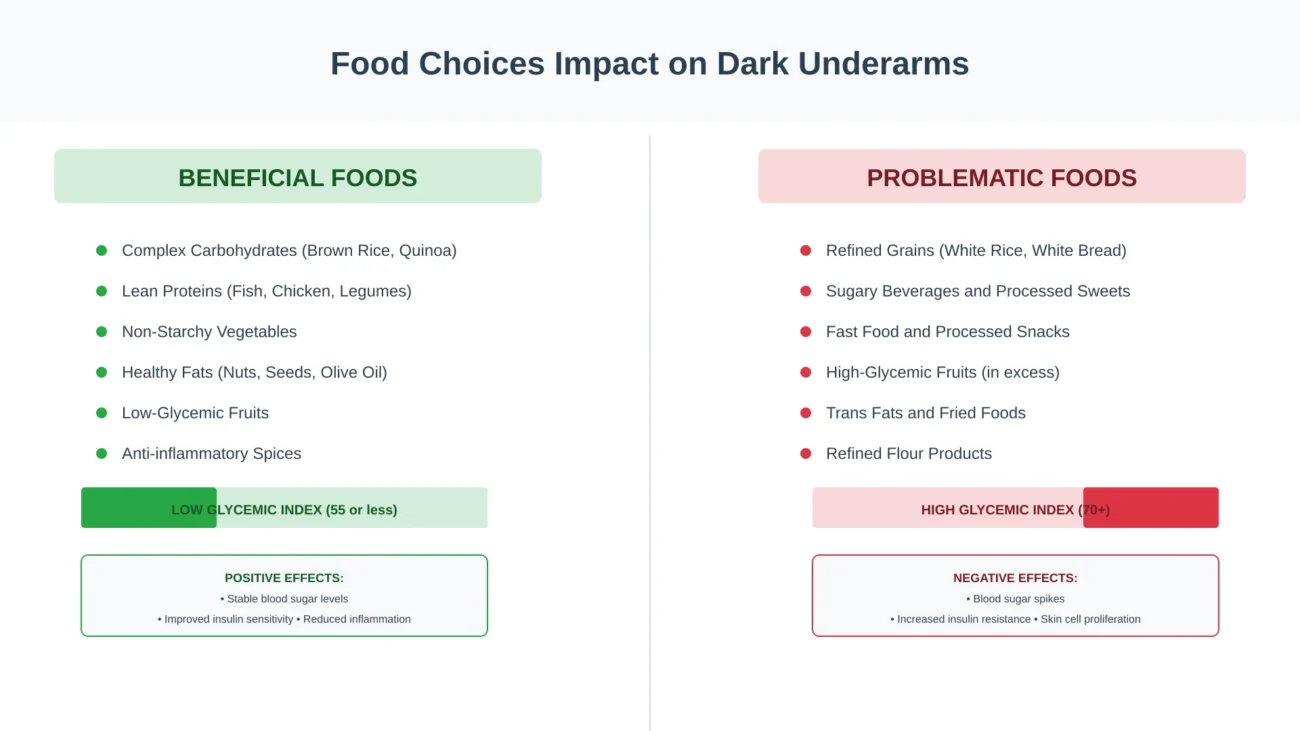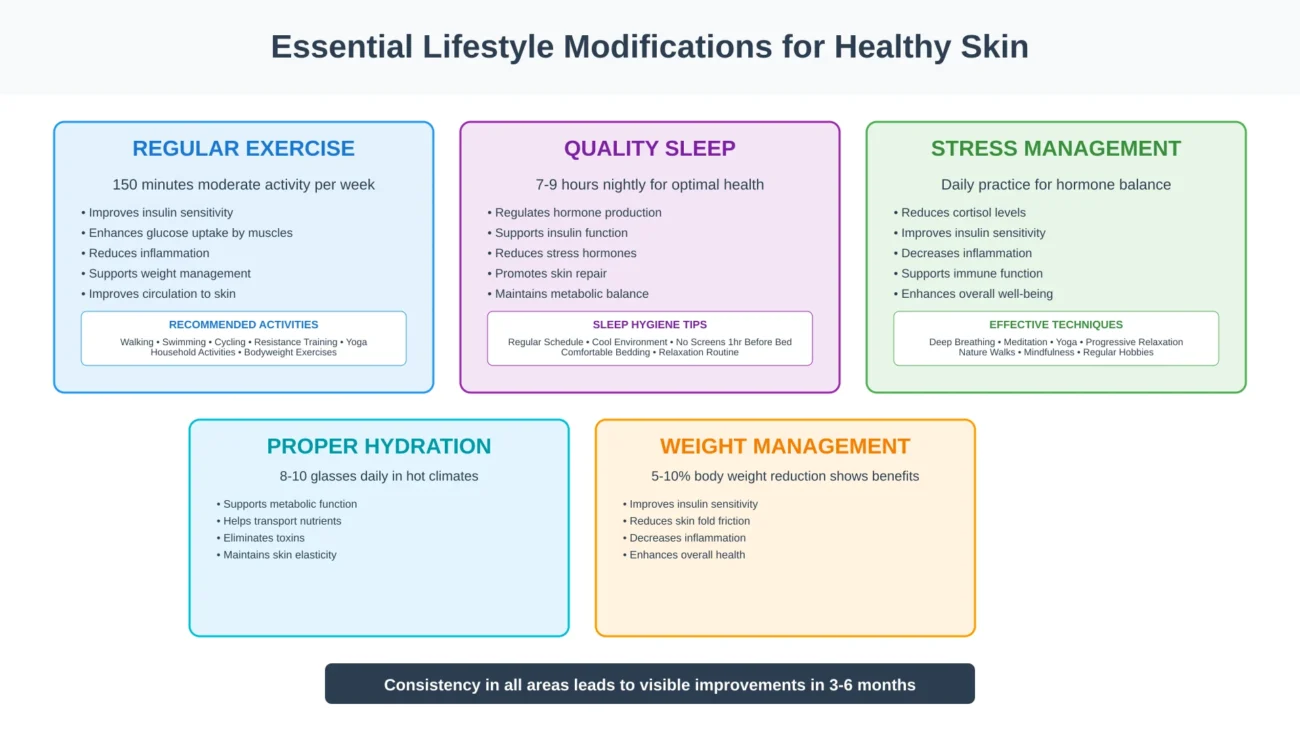Diet and Lifestyle Changes for Dark Underarms: Evidence-Based Guide
Dark underarms and neck patches, medically known as acanthosis nigricans, are primarily caused by insulin resistance and metabolic dysfunction. While medical and evidence based natural treatments exist, diet and lifestyle modifications form the foundation of effective management and prevention. This comprehensive guide provides evidence-based strategies to address the root causes through sustainable changes.
Understanding the Diet-Skin Connection:
The development of dark patches in skin folds is closely linked to how your body processes food and manages blood sugar levels. When you consume high-glycemic foods, your blood sugar spikes rapidly, causing your pancreas to release large amounts of insulin. Over time, cells become less responsive to insulin, leading to chronically elevated insulin levels that stimulate skin cell growth and pigmentation.
This insulin resistance pathway is the primary mechanism behind acanthosis nigricans, making diet and lifestyle interventions crucial for both treatment and prevention. Understanding this connection empowers you to make informed choices about your daily habits and food selections.
Foods That Worsen the Condition:
Certain dietary choices can exacerbate insulin resistance and worsen dark underarm patches. High-glycemic foods cause rapid blood sugar spikes, leading to increased insulin production and inflammation. These problematic foods include:
White rice and refined grains create immediate glucose surges in the bloodstream. Sugary drinks and processed sweets provide empty calories while dramatically affecting blood sugar control. Fast food and processed snacks often contain hidden sugars and unhealthy fats that promote inflammation. Refined flour products like white bread, commercial pastries, and processed baked goods contribute to metabolic dysfunction.
Beneficial Foods for Skin Health:
Diet and lifestyle changes should emphasize foods that support stable blood sugar levels and reduce inflammation. Complex carbohydrates with high fiber content provide sustained energy without causing dramatic insulin spikes. These include whole grains, legumes, and vegetables.
Lean proteins from various sources help maintain steady blood sugar levels and support skin repair. Fish, poultry, eggs, and plant-based proteins provide essential amino acids without contributing to glycemic load. Healthy fats from nuts, seeds, olive oil, and avocados support hormone production and reduce inflammation.
Non-starchy vegetables should form the foundation of your dietary approach. Dark leafy greens, colorful peppers, tomatoes, and cruciferous vegetables provide antioxidants that combat inflammation and support overall skin health. Low-glycemic fruits like berries, apples, and citrus fruits offer vitamins and fiber without excessive sugar content.

The Glycemic Index Approach
Understanding glycemic index (GI) values helps guide food choices for better blood sugar control. Low GI foods (55 or less) cause slow, steady blood sugar rises and are preferred for managing insulin resistance. Medium GI foods (56-69) have moderate blood sugar impact and should be consumed in moderation. High GI foods (70+) cause rapid blood sugar spikes and should be limited or avoided.
Practical examples include choosing brown rice over white rice, whole grain bread over refined white bread, and steel-cut oats over instant cereals. This approach allows for flexibility while maintaining focus on metabolic health.
Essential Lifestyle Modifications:
Beyond dietary changes, several lifestyle factors significantly impact insulin sensitivity and skin health. Regular physical activity is one of the most effective interventions for improving insulin resistance. Both aerobic exercise and resistance training help muscles utilize glucose more efficiently, reducing insulin requirements.
Exercise doesn’t require expensive gym memberships or equipment. Walking, cycling, swimming, bodyweight exercises, and household activities all contribute to improved metabolic health. Consistency matters more than intensity, with 150 minutes of moderate activity weekly being the recommended target.
Sleep and Stress Management:
Quality sleep and stress management are often overlooked but crucial components of any diet and lifestyle intervention. Poor sleep disrupts hormone production, including insulin regulation, while chronic stress elevates cortisol levels that worsen insulin resistance.
Establishing regular sleep schedules, creating comfortable sleep environments, and practicing stress-reduction techniques like deep breathing, meditation, or gentle yoga can significantly improve metabolic health. These practices support the body’s natural healing processes and enhance the effectiveness of dietary changes.
Hydration and Weight Management:
Proper hydration supports metabolic function and helps maintain healthy skin. Water helps transport nutrients, eliminate toxins, and maintain skin elasticity. In hot climates, adequate fluid intake becomes even more critical for overall health and skin appearance.
Weight management through sustainable diet and lifestyle changes often leads to improvement in acanthosis nigricans. Even modest weight loss of 5-10% can significantly improve insulin sensitivity and reduce the appearance of dark patches. Focus should be on gradual, sustainable changes rather than rapid weight loss.
Monitoring Progress and Consistency:
Successful management of dark underarms through diet and lifestyle changes requires patience and consistency. Improvements typically become visible after 3-6 months of sustained effort. Taking progress photos, monitoring energy levels, and tracking other health markers can help maintain motivation during the improvement process.
Remember that individual responses vary, and what works for one person may need adjustment for another. Working with healthcare providers ensures that your diet and lifestyle approach is safe and appropriate for your specific health status.
Long-term Success Strategies:
Sustainable diet and lifestyle changes focus on creating new habits rather than temporary restrictions. Gradual implementation of changes allows for better adaptation and long-term adherence. Building support systems, whether through family involvement or healthcare guidance, improves success rates significantly.
The goal is developing a lifestyle that naturally supports metabolic health, making these beneficial choices feel normal and enjoyable rather than restrictive or challenging.

Medical Disclaimer: This information is for educational purposes only and should not replace professional medical treatment. Consult with qualified healthcare providers for personalized guidance regarding diet and lifestyle modifications, especially if you have underlying medical conditions or are taking medications.

